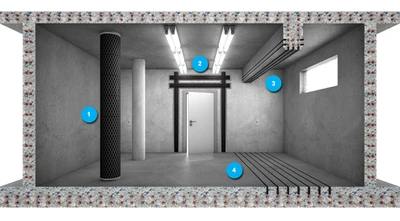Many concrete structures, such as bridges, multi-storey car parks or residential and commercial buildings show signs of wear and tear over time. These often need to be retrofitted. Structural engineers frequently resort to additional steel girders or shotcrete with reinforcement, which is not always necessary and can often be complex and costly. A modern and efficient alternative are carbon fibre-reinforced polymer (CFRP) systems. Compared to traditional methods, these are less complex, more cost-effective and quicker to implement.
Many concrete structures reach their structural limits after decades of intensive use. The causes are often reinforcement damage, corrosion or insufficient load-bearing capacity – particularly in slabs, beams, columns and tension or compression zones. Conventional reinforcement methods, such as the use of steel girders or additional concrete layers with reinforcement, often reach their limits: they require space, alter the geometry of the structure and add significant self-weight. Retrofitting with carbon fibre-reinforced polymers (CFRP), whether as lamellas or sheets, offers numerous advantages compared with conventional reinforcement methods, particularly in terms of personnel and material usage, installation height and construction time.
Possible applications for CFRP composites.
1. Support strapping with CF sheets to activate multiaxial strength
2. Bending reinforcement with CFRP lamellas bonded to the surface in case of subsequent breakouts
3. Bending tensile reinforcement of a joist with CFRP lamellas bonded into slots
4. Subsequent crack width restriction in the floor area with CFRP lamellas bonded into slots.

When retrofitting concrete components such as slabs, beams and columns, steel girders or shotcrete are often used. However, their thickness can significantly reduce the available headroom. In contrast, CFRP lamellas are very thin (under 0.5 cm), lightweight and can also be bonded into slots cut into the concrete, thus preserving the structural clearance – a clear advantage in bridges and car parks with limited headspace. CFRP components are also significantly lighter and easier to handle than steel, requiring no additional support during installation – something that is not feasible with steel or shotcrete. While shotcrete reaches full load-bearing capacity only after 28 days, CFRP reinforcements can be fully loaded just two days after installation, significantly reducing construction and closure times.
Although CFRP lamellas are more expensive than steel, they are often more economical when considering total costs such as downtime, site setup and labour. Accurate preliminary design is essential to determine required strip cross-section and to calculate the associated costs precisely. Our in-house design software Lasoft 4.0 provides support in this process.
Strengthening measures using CFRP components offer a cost-effective and time-saving alternative to conventional methods for retrofitting concrete structures. With professional planning and design, CFRP strips enable faster execution, reduced labour and significantly shortened downtime. The greatly reduced downtime, in particular, enables considerable cost savings due to rapid recommissioning and shorter construction periods. The strengthening systems from MC-Bauchemie possess general building approval.
The CFRP lamellas from MC allow for quick and economical strengthening of reinforced concrete components. They are either bonded to the surface of the concrete or embedded into pre-cut slots. Their minimal material thickness ensures that the existing geometry is hardly altered, if at all. This is particularly advantageous in confined spaces – e.g., in car parks, bridges or beneath walkable ceilings.
For complex, curved components such as columns or tunnel linings, the flexible carbon fibre sheets (CF sheets) are ideal. These are applied to the entire surface of the component and activate the multi-axial load-bearing capacity of the concrete. In this way, the load-bearing capacity can be significantly increased. The flexible sheets adapt perfectly to complex shapes and provide effective strengthening without heavy equipment or extensive modification work.
We are continuously improving our website and we use cookies for this purpose. For an optimal user experience, we recommend that you accept them. Otherwise, parts of the page will be deactivated in the display in accordance with data protection regulations.